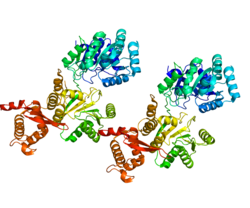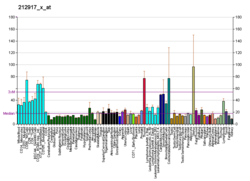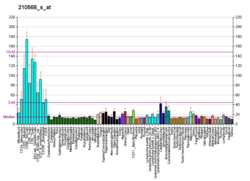Protein-coding gene in the species Homo sapiens
| RECQL |
|---|
 |
| Available structures |
|---|
| PDB | Ortholog search: PDBe RCSB |
|---|
| List of PDB id codes |
|---|
2V1X, 2WWY, 4U7D |
|
|
| Identifiers |
|---|
| Aliases | RECQL, RECQL1, RecQ1, RecQ like helicase |
|---|
| External IDs | OMIM: 600537; MGI: 103021; HomoloGene: 56279; GeneCards: RECQL; OMA:RECQL - orthologs |
|---|
| Gene location (Human) |
|---|
 | | Chr. | Chromosome 12 (human)[1] |
|---|
| | Band | 12p12.1 | Start | 21,468,910 bp[1] |
|---|
| End | 21,501,669 bp[1] |
|---|
|
| Gene location (Mouse) |
|---|
 | | Chr. | Chromosome 6 (mouse)[2] |
|---|
| | Band | 6 G2|6 73.91 cM | Start | 142,296,068 bp[2] |
|---|
| End | 142,332,813 bp[2] |
|---|
|
| RNA expression pattern |
|---|
| Bgee | | Human | Mouse (ortholog) |
|---|
| Top expressed in | - buccal mucosa cell
- tibia
- Achilles tendon
- parietal pleura
- visceral pleura
- superficial temporal artery
- mucosa of paranasal sinus
- synovial joint
- oral cavity
- skin of hip
|
| | Top expressed in | - spermatid
- spermatocyte
- neural layer of retina
- Paneth cell
- barrel cortex
- thymus
- otic placode
- primitive streak
- yolk sac
- ventricular zone
|
| | More reference expression data |
|
|---|
| BioGPS | 

 | | More reference expression data |
|
|---|
|
| Gene ontology |
|---|
| Molecular function | - ATP-dependent DNA/DNA annealing activity
- nucleotide binding
- DNA helicase activity
- protein binding
- hydrolase activity
- ATP binding
- helicase activity
- nucleic acid binding
- DNA binding
- 3'-5' DNA helicase activity
- four-way junction helicase activity
| | Cellular component | - membrane
- nucleoplasm
- chromosome
- cytoplasm
- nucleus
| | Biological process | - DNA recombination
- DNA repair
- double-strand break repair via homologous recombination
- DNA duplex unwinding
- DNA unwinding involved in DNA replication
| | Sources:Amigo / QuickGO |
|
| Orthologs |
|---|
| Species | Human | Mouse |
|---|
| Entrez | | |
|---|
| Ensembl | | |
|---|
| UniProt | | |
|---|
| RefSeq (mRNA) | | |
|---|
NM_001204906
NM_001204907
NM_023042
NM_001355511 |
|
|---|
| RefSeq (protein) | | |
|---|
NP_001191835
NP_001191836
NP_075529
NP_001342440 |
|
|---|
| Location (UCSC) | Chr 12: 21.47 – 21.5 Mb | Chr 6: 142.3 – 142.33 Mb |
|---|
| PubMed search | [3] | [4] |
|---|
|
| Wikidata |
| View/Edit Human | View/Edit Mouse |
|
ATP-dependent DNA helicase Q1 is an enzyme that in humans is encoded by the RECQL gene.[5][6][7]
The protein encoded by this gene is a member of the RecQ DNA helicase family. DNA helicases are enzymes involved in various types of DNA repair, including mismatch repair, nucleotide excision repair and direct repair. Some members of this family are associated with genetic disorders with predisposition to malignancy and chromosomal instability. The biological function of this helicase has not yet been determined. Two alternatively spliced transcripts, which encode the same isoform but differ in their 5' and 3' UTRs, have been described.[7]
Interactions
RECQL has been shown to interact with KPNA4[8] and Karyopherin alpha 2.[8]
References
- ^ a b c GRCh38: Ensembl release 89: ENSG00000004700 – Ensembl, May 2017
- ^ a b c GRCm38: Ensembl release 89: ENSMUSG00000030243 – Ensembl, May 2017
- ^ "Human PubMed Reference:". National Center for Biotechnology Information, U.S. National Library of Medicine.
- ^ "Mouse PubMed Reference:". National Center for Biotechnology Information, U.S. National Library of Medicine.
- ^ Seki M, Miyazawa H, Tada S, Yanagisawa J, Yamaoka T, Hoshino S, Ozawa K, Eki T, Nogami M, Okumura K, et al. (January 1995). "Molecular cloning of cDNA encoding human DNA helicase Q1 which has homology to Escherichia coli Rec Q helicase and localization of the gene at chromosome 12p12". Nucleic Acids Res. 22 (22): 4566–73. doi:10.1093/nar/22.22.4566. PMC 308502. PMID 7527136.
- ^ Puranam KL, Blackshear PJ (December 1994). "Cloning and characterization of RECQL, a potential human homologue of the Escherichia coli DNA helicase RecQ". J Biol Chem. 269 (47): 29838–45. doi:10.1016/S0021-9258(18)43957-9. PMID 7961977.
- ^ a b "Entrez Gene: RECQL RecQ protein-like (DNA helicase Q1-like)".
- ^ a b Seki, T; Tada S; Katada T; Enomoto T (May 1997). "Cloning of a cDNA encoding a novel importin-alpha homologue, Qip1: discrimination of Qip1 and Rch1 from hSrp1 by their ability to interact with DNA helicase Q1/RecQL". Biochem. Biophys. Res. Commun. 234 (1). UNITED STATES: 48–53. doi:10.1006/bbrc.1997.6535. ISSN 0006-291X. PMID 9168958.
Further reading
- Puranam KL, Kennington E, Sait SN, et al. (1995). "Chromosomal localization of the gene encoding the human DNA helicase RECQL and its mouse homologue". Genomics. 26 (3): 595–8. doi:10.1016/0888-7543(95)80181-K. PMID 7607686.
- Seki M, Yanagisawa J, Kohda T, et al. (1994). "Purification of two DNA-dependent adenosinetriphosphatases having DNA helicase activity from HeLa cells and comparison of the properties of the two enzymes". J. Biochem. 115 (3): 523–31. doi:10.1093/oxfordjournals.jbchem.a124369. PMID 8056767.
- Seki T, Tada S, Katada T, Enomoto T (1997). "Cloning of a cDNA encoding a novel importin-alpha homologue, Qip1: discrimination of Qip1 and Rch1 from hSrp1 by their ability to interact with DNA helicase Q1/RecQL". Biochem. Biophys. Res. Commun. 234 (1): 48–53. doi:10.1006/bbrc.1997.6535. PMID 9168958.
- Weinmann AS, Yan PS, Oberley MJ, et al. (2002). "Isolating human transcription factor targets by coupling chromatin immunoprecipitation and CpG island microarray analysis". Genes Dev. 16 (2): 235–44. doi:10.1101/gad.943102. PMC 155318. PMID 11799066.
- Zhang AH, Xi X (2003). "Molecular cloning of a splicing variant of human RECQL helicase". Biochem. Biophys. Res. Commun. 298 (5): 789–92. doi:10.1016/S0006-291X(02)02542-1. PMID 12419324.
- Cui S, Klima R, Ochem A, et al. (2003). "Characterization of the DNA-unwinding activity of human RECQ1, a helicase specifically stimulated by human replication protein A". J. Biol. Chem. 278 (3): 1424–32. doi:10.1074/jbc.M209407200. PMID 12419808.
- Strausberg RL, Feingold EA, Grouse LH, et al. (2003). "Generation and initial analysis of more than 15,000 full-length human and mouse cDNA sequences". Proc. Natl. Acad. Sci. U.S.A. 99 (26): 16899–903. Bibcode:2002PNAS...9916899M. doi:10.1073/pnas.242603899. PMC 139241. PMID 12477932.
- Cui S, Arosio D, Doherty KM, et al. (2004). "Analysis of the unwinding activity of the dimeric RECQ1 helicase in the presence of human replication protein A". Nucleic Acids Res. 32 (7): 2158–70. doi:10.1093/nar/gkh540. PMC 407823. PMID 15096578.
- Gerhard DS, Wagner L, Feingold EA, et al. (2004). "The status, quality, and expansion of the NIH full-length cDNA project: the Mammalian Gene Collection (MGC)". Genome Res. 14 (10B): 2121–7. doi:10.1101/gr.2596504. PMC 528928. PMID 15489334.
- Doherty KM, Sharma S, Uzdilla LA, et al. (2005). "RECQ1 helicase interacts with human mismatch repair factors that regulate genetic recombination". J. Biol. Chem. 280 (30): 28085–94. doi:10.1074/jbc.M500265200. PMID 15886194.
- Sharma S, Sommers JA, Choudhary S, et al. (2005). "Biochemical analysis of the DNA unwinding and strand annealing activities catalyzed by human RECQ1". J. Biol. Chem. 280 (30): 28072–84. doi:10.1074/jbc.M500264200. PMID 15899892.
- LeRoy G, Carroll R, Kyin S, et al. (2005). "Identification of RecQL1 as a Holliday junction processing enzyme in human cell lines". Nucleic Acids Res. 33 (19): 6251–7. doi:10.1093/nar/gki929. PMC 1275589. PMID 16260474.
- Muzzolini L, Beuron F, Patwardhan A, et al. (2007). "Different quaternary structures of human RECQ1 are associated with its dual enzymatic activity". PLOS Biol. 5 (2): e20. doi:10.1371/journal.pbio.0050020. PMC 1769423. PMID 17227144.
- Xie J, Bessling SL, Cooper TK, et al. (2007). "Manipulating mitotic recombination in the zebrafish embryo through RecQ helicases". Genetics. 176 (2): 1339–42. doi:10.1534/genetics.107.072983. PMC 1894594. PMID 17483412.





















